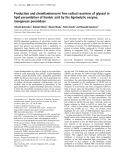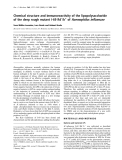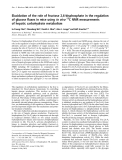
This Provisional PDF corresponds to the article as it appeared upon acceptance. Fully formatted
PDF and full text (HTML) versions will be made available soon.
Adiponectin receptor-1 expression is associated with good prognosis in gastric
cancer
Journal of Experimental & Clinical Cancer Research 2011, 30:107 doi:10.1186/1756-9966-30-107
Tomoya Tsukada (tkd_tmy@nifty.com)
Sachio Fushida (fushida@staff.kanazawa-u.ac.jp)
Shinichi Harada (biomedic@med.kanazawa-u.ac.jp)
Shiroh Terai (temple46jp@yahoo.co.jp)
Yasumichi Yagi (y-yagi@live.jp)
Jun Kinoshita (junkino0416@gmail.com)
Katsunobu Oyama (oya-ma@staff.kanazawa-u.ac.jp)
Hidehiro Tajima (hidetaji@staff.kanazawa-u.ac.jp)
Hideto Fujita (hfujita@mail.kanazawa-u.ac.jp)
Itasu Ninomiya (nino@staff.kanazawa-u.ac.jp)
Takashi Fujimura (tphuji@staff.kanazawa-u.ac.jp)
Tetsuo Ohta (ohtat@staff.kanazawa-u.ac.jp)
ISSN 1756-9966
Article type Research
Submission date 14 September 2011
Acceptance date 11 November 2011
Publication date 11 November 2011
Article URL http://www.jeccr.com/content/30/1/107
This peer-reviewed article was published immediately upon acceptance. It can be downloaded,
printed and distributed freely for any purposes (see copyright notice below).
Articles in Journal of Experimental & Clinical Cancer Research are listed in PubMed and archived at
PubMed Central.
For information about publishing your research in Journal of Experimental & Clinical Cancer
Research or any BioMed Central journal, go to
http://www.jeccr.com/authors/instructions/
Journal of Experimental &
Clinical Cancer Research
© 2011 Tsukada et al. ; licensee BioMed Central Ltd.
This is an open access article distributed under the terms of the Creative Commons Attribution License (http://creativecommons.org/licenses/by/2.0),
which permits unrestricted use, distribution, and reproduction in any medium, provided the original work is properly cited.

For information about other BioMed Central publications go to
http://www.biomedcentral.com/
Journal of Experimental &
Clinical Cancer Research
© 2011 Tsukada et al. ; licensee BioMed Central Ltd.
This is an open access article distributed under the terms of the Creative Commons Attribution License (http://creativecommons.org/licenses/by/2.0),
which permits unrestricted use, distribution, and reproduction in any medium, provided the original work is properly cited.

pg. 1
Adiponectin receptor
Adiponectin receptorAdiponectin receptor
Adiponectin receptor
1
11
1 expression
expressionexpression
expression is associated with
is associated withis associated with
is associated with good
goodgood
good prognosis in
prognosis inprognosis in
prognosis in
gastriccancer
gastriccancergastriccancer
gastriccancer
Tomoya Tsukada1*, Sachio Fushida1, Shinichi Harada2, Shiroh Terai1,
Yasumichi Yagi1, Jun Kinoshita1, Katsunobu Oyama1, Hidehiro Tajima1,
HidetoFujita1,ItasuNinomiya1,TakashiFujimura1,TetsuoOhta1
1Department of Gastroenterological Surgery, Division of Cancer Medicine,
Graduate School of Medical Science, Kanazawa University, 131
Takaramachi, Kanazawa, Ishikawa 9208641, Japan; 2Center for
Biomedical Research and Education, School of Medicine, Kanazawa
University,131Takaramachi,Kanazawa,Ishikawa9208641,Japan
*Correspondingauthor.
Department of Gastroenterological Surgery, Division of Cancer Medicine, Graduate
School of Medical Science, Kanazawa University, 131 Takaramachi, Kanazawa,
Ishikawa9208641,Japan
Phone:81762652362
Fax:81762344260
Email:tkd_tmy@nifty.com
Emailaddresses
SF:fushida@staff.kanazawau.ac.jp
SH:biomedic@med.kanazawau.ac.jp
ST:temple46jp@yahoo.co.jp
YY:yyagi@live.jp
JK:junkino0416@gmail.com
KO:oyama@staff.kanazawau.ac.jp
HT:hidetaji@staff.kanazawau.ac.jp
HF:hfujita@mail.kanazawau.ac.jp
IN:nino@staff.kanazawau.ac.jp
TF:tphuji@staff.kanazawau.ac.jp
TO:ohtat@staff.kanazawau.ac.jp

pg. 2
Abstract
AbstractAbstract
Abstract
Background:
Background:Background:
Background:AdiponectinisinverselyrelatedtoBMI,positivelycorrelates
withinsulinsensitivity,andhasantiatherogeniceffects.Inrecentyears,
adiponectinhasbeenwellstudiedinthefieldofoncology.Adiponectinhas
beenshowntohaveantiproliferativeeffectsongastriccancer,and
adiponectinexpressionisinverselycorrelatedwithclinicalstagingofthe
disease.However,nostudieshavereportedthecorrelationbetweenserum
adiponectinandreceptorexpressionwithdiseaseprogression.
Methods:
Methods:Methods:
Methods:Inthisstudy,weevaluatedexpressionlevelsof2adiponectin
receptors—AdipoR1andAdipoR2—andattemptedtocorrelatetheir
expressionwithprognosisingastriccancerpatients.AdipoR1andAdipoR2
expressioningastriccancercelllines(MKN45,TMK1,NUGC3,and
NUGC4)wasevaluatedbywesternblottinganalysis,andthe
antiproliferativepotentialofadiponectinwasexaminedinvitro.Serum
adiponectinlevelswereevaluatedin100gastriccancerpatients,andthe
expressionofAdipoR1andAdipoR2wasassessedbyimmunohistochemical
staining.
Results:
Results:Results:
Results:MKN45andNUGC3expressedhigherlevelsofAdipoR1compared
toNUGC4,eventhoughtherewasnosignificanceinAdipoR2expression.
TheantiproliferativeeffectofadiponectinwasconfirmedinMKN45and
NUGC3at10Dg/ml.Nosignificantassociationswereobservedbetween
serumadiponectinlevelsandclinicopathologicalcharacteristics,but
lymphaticmetastasisandperitonealdisseminationweresignificantlyhigher

pg. 3
inthenegativeAdipoR1immunostaininggroup(24/32,
p
=0.013and9/32,
p
=0.042,respectively)comparedtothepositiveAdipoR1group(lymphatic
metastasis,33/68;peritonealdissemination,8/68).Ontheotherhand,
AdipoR2expressionwasonlyassociatedwithhistopathologicaltype(
p
=
0.001).Insurvivalanalysis,theAdipoR1positivestaininggrouphad
significantlylongersurvivalratesthanthenegativestaininggroup(
p
=0.01).
However,multivariateanalysisindicatedthatAdipoR1wasnotan
independentprognosticfactoronpatient’ssurvivalongastriccancer.
Conclusions:
Conclusions:Conclusions:
Conclusions:Ingastriccancer,adiponectinhasthepossibilitytobeinvolved
incellgrowthsuppressionviaAdipoR1.ThepresenceofAdipoR1couldbea
novelanticancertherapeutictargetingastriccancer.
Keywords
KeywordsKeywords
Keywords:
Adiponectin,AdipoR1,AdipoR2,gastriccancer,survival


























